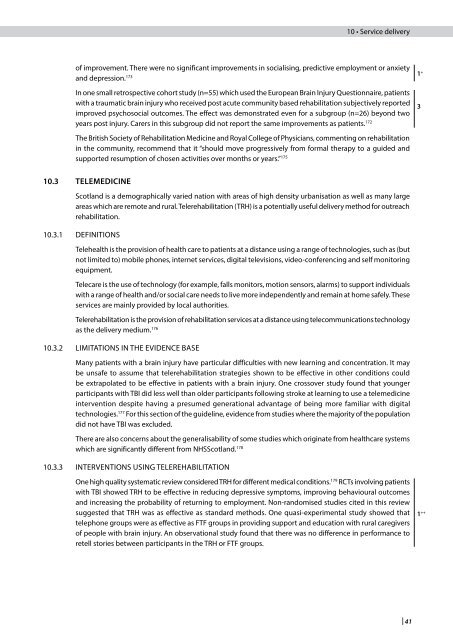sign130
sign130
sign130
Create successful ePaper yourself
Turn your PDF publications into a flip-book with our unique Google optimized e-Paper software.
of improvement. There were no significant improvements in socialising, predictive employment or anxiety<br />
and depression. 173<br />
In one small retrospective cohort study (n=55) which used the European Brain Injury questionnaire, patients<br />
with a traumatic brain injury who received post acute community based rehabilitation subjectively reported<br />
improved psychosocial outcomes. The effect was demonstrated even for a subgroup (n=26) beyond two<br />
years post injury. Carers in this subgroup did not report the same improvements as patients. 172<br />
The British Society of Rehabilitation Medicine and Royal College of Physicians, commenting on rehabilitation<br />
in the community, recommend that it “should move progressively from formal therapy to a guided and<br />
supported resumption of chosen activities over months or years.” 175<br />
10.3 TElEMEDICINE<br />
Scotland is a demographically varied nation with areas of high density urbanisation as well as many large<br />
areas which are remote and rural. Telerehabilitation (TRH) is a potentially useful delivery method for outreach<br />
rehabilitation.<br />
10.3.1 DEFINITIONS<br />
Telehealth is the provision of health care to patients at a distance using a range of technologies, such as (but<br />
not limited to) mobile phones, internet services, digital televisions, video-conferencing and self monitoring<br />
equipment.<br />
Telecare is the use of technology (for example, falls monitors, motion sensors, alarms) to support individuals<br />
with a range of health and/or social care needs to live more independently and remain at home safely. These<br />
services are mainly provided by local authorities.<br />
Telerehabilitation is the provision of rehabilitation services at a distance using telecommunications technology<br />
as the delivery medium. 176<br />
10.3.2 LIMITATIONS IN THE EVIDENCE BASE<br />
Many patients with a brain injury have particular difficulties with new learning and concentration. It may<br />
be unsafe to assume that telerehabilitation strategies shown to be effective in other conditions could<br />
be extrapolated to be effective in patients with a brain injury. One crossover study found that younger<br />
participants with TBI did less well than older participants following stroke at learning to use a telemedicine<br />
intervention despite having a presumed generational advantage of being more familiar with digital<br />
technologies. 177 For this section of the guideline, evidence from studies where the majority of the population<br />
did not have TBI was excluded.<br />
There are also concerns about the generalisability of some studies which originate from healthcare systems<br />
which are significantly different from NHSScotland. 178<br />
10.3.3 INTERVENTIONS USING TELEREHABILITATION<br />
10 • Service delivery<br />
One high quality systematic review considered TRH for different medical conditions. 179 RCTs involving patients<br />
with TBI showed TRH to be effective in reducing depressive symptoms, improving behavioural outcomes<br />
and increasing the probability of returning to employment. Non-randomised studies cited in this review<br />
suggested that TRH was as effective as standard methods. One quasi-experimental study showed that<br />
telephone groups were as effective as FTF groups in providing support and education with rural caregivers<br />
of people with brain injury. An observational study found that there was no difference in performance to<br />
retell stories between participants in the TRH or FTF groups.<br />
| 41<br />
1 +<br />
3<br />
1 ++


